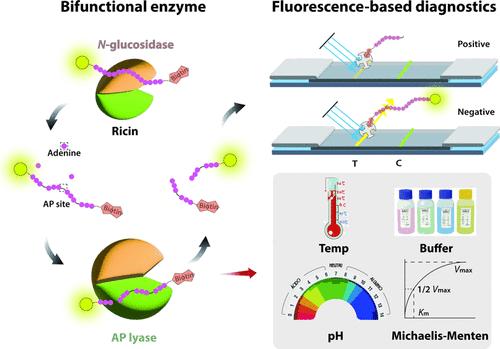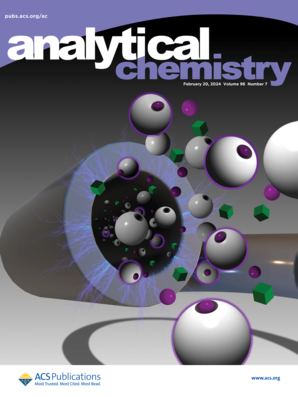Innovative Ricin Toxin Detection: Unraveling Apurinic/Apyrimidinic Lyase Activity and Developing Fluorescence Sensors
IF 6.7
1区 化学
Q1 CHEMISTRY, ANALYTICAL
引用次数: 0
Abstract
Ricin toxin (RT) is a potential bioterrorism agent because of its high potency, extremely small lethal dose, ease of preparation, and notable stability. Therefore, a portable method is urgently required to efficiently detect and determine the presence of toxicity of RT and evaluate its potency for public health monitoring and counter-bioterrorism responses. Currently, enzyme-based assays for detecting RT mainly focus on its N-glycosidase activity. In this study, we demonstrated that RT exhibits apurinic/apyrimidinic (AP) lyase activity using several methods. Characterization of the enzyme reaction and kinetics revealed that AP lyase activity is optimal at 59 °C and pH 4.0. This activity is highly pH-sensitive, remaining active between pH 3.0 and pH 4.6. Furthermore, we developed a portable fluorescence-based lateral flow assay (FLFA) that detects RT much faster than existing assays based on its N-glycosidase activity. Moreover, this assay can efficiently detect RT at nanogram levels from complex matrix samples within 1.5 h while simultaneously determining its biological activity. In conclusion, the discovery of the AP lyase activity of RT and the development of FLFA represent novel approaches for studying the enzymatic profiles of other ribosome-inactivating proteins.

创新的蓖麻毒素检测:解开无尿嘧啶/无嘧啶裂解酶活性和开发荧光传感器
蓖麻毒素(Ricin toxin, RT)具有效价高、致死剂量极小、制备方便、稳定性好等优点,是一种潜在的生物恐怖制剂。因此,迫切需要一种便携式方法来有效地检测和确定RT的毒性,并评估其在公共卫生监测和反恐反应中的效力。目前,基于酶的RT检测方法主要集中于检测RT的n -糖苷酶活性。在这项研究中,我们通过几种方法证明了RT具有apurinic/apyrimidinic (AP)裂解酶活性。酶反应和动力学表征表明,在59°C和pH 4.0条件下,AP裂解酶活性最佳。这种活性对pH高度敏感,在pH 3.0到pH 4.6之间保持活性。此外,我们开发了一种便携式基于荧光的横向流动试验(FLFA),比现有的基于其n -糖苷酶活性的检测方法更快地检测RT。此外,该方法可以在1.5 h内有效地从复杂基质样品中检测到纳克水平的RT,同时测定其生物活性。总之,RT的AP裂解酶活性的发现和FLFA的发展为研究其他核糖体失活蛋白的酶谱提供了新的途径。
本文章由计算机程序翻译,如有差异,请以英文原文为准。
求助全文
约1分钟内获得全文
求助全文
来源期刊

Analytical Chemistry
化学-分析化学
CiteScore
12.10
自引率
12.20%
发文量
1949
审稿时长
1.4 months
期刊介绍:
Analytical Chemistry, a peer-reviewed research journal, focuses on disseminating new and original knowledge across all branches of analytical chemistry. Fundamental articles may explore general principles of chemical measurement science and need not directly address existing or potential analytical methodology. They can be entirely theoretical or report experimental results. Contributions may cover various phases of analytical operations, including sampling, bioanalysis, electrochemistry, mass spectrometry, microscale and nanoscale systems, environmental analysis, separations, spectroscopy, chemical reactions and selectivity, instrumentation, imaging, surface analysis, and data processing. Papers discussing known analytical methods should present a significant, original application of the method, a notable improvement, or results on an important analyte.
 求助内容:
求助内容: 应助结果提醒方式:
应助结果提醒方式:


